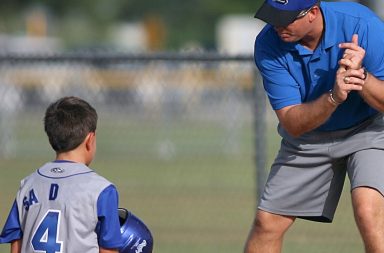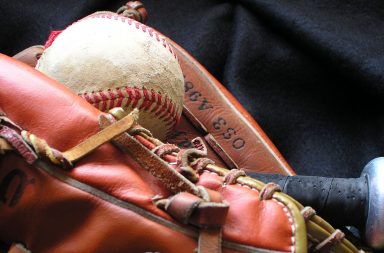My eight year old was playing baseball this fall on a coach pitched team. It was the perfect situation for the fall with only one practice every Sunday afternoon from 2:00-3:30. It was a great experience, one in which he learned a lot and he had a great time with the other kids on the team. We were also playing flag football this fall, so we didnt have a lot of time for extended fall ball, plus he is only 8 so I wasnt interested in him being involved with a team that was going to play games every week.(Im not a big proponent of playing year round baseball, but Ill save that for another article.)
The coaches decided they would try to play a couple of games and put into action what they had been teaching during the Sunday practices. We traveled about 45 minutes away on a nice Saturday during the middle of the fall to play a double header with another eight year old team. It was a good experience but I was shocked when I watched the other team hit. Yes, they beat us in both games 20-8 and 17-9, but that wasnt what shocked me, it was the bats they were using ‘ Big Barrel Baseball Bats.
Let me back up a little bit first. My eight year old is our youngest. My oldest is 26 (I was 40 when our youngest was born) and we have already went through Little League, Babe Ruth, Summer Ball, etc with our oldest. Also, as a high school baseball coach I host youth camps every summer and thought I was in tune with what was happening in youth baseball. But the bats I saw the other eight year old team using that day caught me by complete surprise. Every player on the other team was using a big barrel baseball bat (2-5/8 inch) even though they were only eight years old.
The big barrel baseball bat is designed for senior league play, which is typically 13-15 year olds. I did a little investigation and found that all the manufacturers (Easton, DeMarini, Louisville, etc) specifically advertise these big barrel baseball bats are not approved for younger youth league teams. This was reinforced more when I found out that most youth leagues (Cal Ripen, Little League, Pony, etc.,.) did not allow players to use the larger barrel bats. However, I did find it odd that the manufacturers are making -10 to -13 drop bats (the unit distinction between the length and the weight of the bat, such as 27 inches long and 17 ounces in weight). Its obvious that the sale of these ultra-light, big barrel baseball bats are targeted at youth league players.
Youth league (ages 6-12) aluminum bats are typically 2 ‘ inches in diameter at the sweet spot and usually have a -8 in drop. The idea is to work up as they get older and eventually get to the -3 drop bat that is required in high school.
The problem with using big barrel baseball bats at such a young age is that it doesnt reinforce hitting mechanics. When a young hitter swings and misses the sweet spot, this reinforces the fact they need to use their hands to hit instead of their arms. The sweet spot is typically 4-7 inches from the barrel end of the bat, located between the bats trademark and the end of the bat. With aluminum (or composite bats) when the player misses the sweet spot the bat jars in their hands. With a wood bat (which I think all young players should spend time learning to hit with) if the sweet spot is missed the ball doesn’t travel very far, maybe a ground ball to second or short. Anyway, it reinforces the need to rotate the hips and use the hands and forearms to get the barrel of the bat on the ball.
With much practice a player can become good at making consistent contact on the sweet spot of the bat. Using the hands correctly will strengthen the hands as they get older and allow them to progress in their mechanics as a hitter. Many players struggle with hitting on high school freshman or JV teams (and middle school teams) because they drag the bat head with the -3 bats that are required by the National Federation rules. They have been swinging the -8 or -5 with their arms and the -3 is heavier for them to swing. They have not yet developed good strong hands or forearms from hitting properly.
Another problem with the big barrel baseball bats is the extended hitting zones. The player can have a long swing (one that disconnects with the arms getting away from the body) hitting the ball on the area below the sweet spot near the trademark and still get a solid base hit into the outfield. This was what I witnessed that Saturday this fall during the eight year old coached/pitched game. Most of the hitters in the on the opposing team used more arms than hands to hit but they still had solid shots into the outfield. In fact, when they did make solid contact the ball was sent like a laser to the outfield fences. Several times our players were hit with the ball (one in the head on a line drive to center field) and the opposing coach was also hit by a hot line drive back to the mound. It was a little scary and these young players were not ready to be swinging these bats.
During my research I also found this was a common practice for travel league teams. Most travel tournament sponsors do not have regulations against using these larger barrel bats for youth league ages. With the manufacture warnings clearly listed on these bats this could be a serious point for litigation. The travel tournament sponsors and teams that allw these bats against the manufacture warnings are exposing themselves to potential lawsuits.
From a hitting stand point players will never understand their hitting flaws. Its like the weekend golfer that uses a monster head driver, one that can correct the flight of the ball if the swing is not perfect. As long as you make contact anywhere on the face of the club youre in good shape. (I got one in my golf bag) The same is true for the large barrel bats for youth leagues. See, hitting a baseball is difficult and comes with much failure. A good big league player that hits around .300 will fail 7 out of 10 times. With young hitters the failure is what makes them better. Missing the sweet spot on the bat reinforces the idea to use your hands and get the barrel on the ball.
If youre serious about your child being a better hitter make them use the 2 inch barrel in youth league. They can also work with a wood bat in practices and scrimmage games. (or summer/fall league play). Use bamboo when they are young moving to maple by the time they are 11 or 12. Both of these bats are extremely durable and hard to break. By the time they are 15-16 they can graduate to a nice Ash bat. Most big leaguers use either Ash or Maple. All of our high school players have a wood bat in their bag and train with it regularly.


